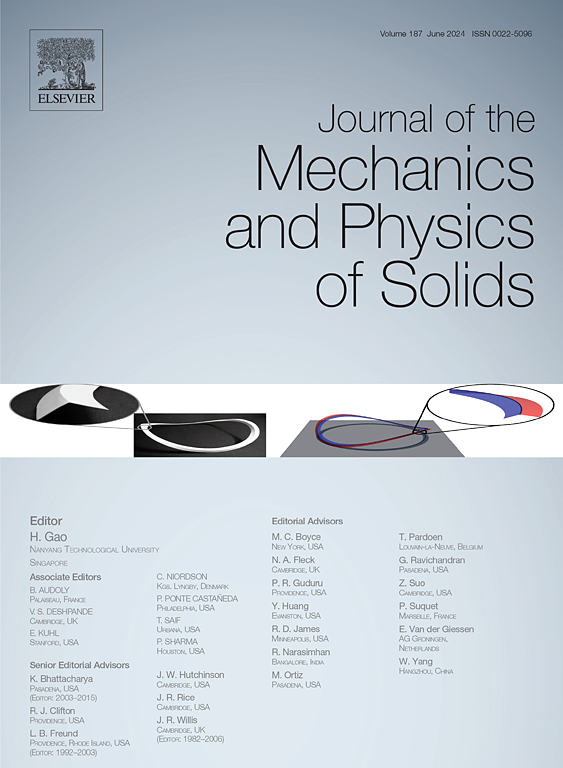Static topological mechanics: from space-time duality to localized deformations
IF 6
2区 工程技术
Q2 MATERIALS SCIENCE, MULTIDISCIPLINARY
引用次数: 0
Abstract
Manipulating localized static deformations in materials that are otherwise sensitive to stochastic imperfections and impurities is a long-standing pursuit in solid mechanics. Developments in topological physics have unveiled an unprecedented paradigm for steering robust, localized transport of mass and energy and have been extended to classical dynamic mechanical systems, known as topological mechanics. Recently, Wang, Zhou, and Chen (2023) showed that phonons are not the only elementary excitations in topological mechanics; topology is also inherent in static load-induced mechanical deformations of lattice materials and elastic continua. In these quasistatic and frequency-irrelevant systems, topologically nontrivial modes manifest as ordered static deformations localized at boundaries or interfaces, providing a new method to rationally regulate localized deformations so that they are robust against structural disorders and defects. In this review, we introduce the fundamental concepts of this topology, referred to as static topological mechanics, emphasizing the space-time duality and the imaginary time transformation between static and associated wave dynamic systems. We outline several archetypal topological states reconstructed in static mechanical systems, including topological zero modes, multipole higher-order topologies, and non-Hermitian topologies. In parallel with their dynamic counterparts, robust static topologies can be harnessed to customize localized deformations, such as constructing multidirectional stress guides in lattice materials. This review concludes by envisioning future challenges and opportunities in static topological mechanics.静态拓扑力学:从时空二象性到局域变形
在对随机缺陷和杂质敏感的材料中控制局部静态变形是固体力学长期以来的追求。拓扑物理学的发展揭示了一种前所未有的模式,用于控制质量和能量的鲁棒、局域输运,并已扩展到经典的动态力学系统,即拓扑力学。最近,Wang, Zhou, and Chen(2023)表明声子不是拓扑力学中唯一的初等激励;在晶格材料和弹性连续体的静载荷引起的机械变形中,拓扑结构也是固有的。在这些准静态和频率无关的系统中,拓扑非平凡模态表现为边界或界面处的有序静态变形,为合理调节局部变形提供了一种新的方法,使其对结构紊乱和缺陷具有鲁棒性。在这篇综述中,我们介绍了这种拓扑的基本概念,称为静态拓扑力学,强调了静态和相关波动力系统之间的时空对偶性和虚时变换。我们概述了在静态机械系统中重构的几种原型拓扑状态,包括拓扑零模式、多极高阶拓扑和非厄米拓扑。与动态拓扑并行,稳健的静态拓扑可以用来定制局部变形,例如在晶格材料中构建多向应力导向。本文最后展望了静态拓扑力学未来的挑战和机遇。
本文章由计算机程序翻译,如有差异,请以英文原文为准。
求助全文
约1分钟内获得全文
求助全文
来源期刊
CiteScore
9.80
自引率
9.40%
发文量
276
审稿时长
52 days
期刊介绍:
The aim of Journal of The Mechanics and Physics of Solids is to publish research of the highest quality and of lasting significance on the mechanics of solids. The scope is broad, from fundamental concepts in mechanics to the analysis of novel phenomena and applications. Solids are interpreted broadly to include both hard and soft materials as well as natural and synthetic structures. The approach can be theoretical, experimental or computational.This research activity sits within engineering science and the allied areas of applied mathematics, materials science, bio-mechanics, applied physics, and geophysics.
The Journal was founded in 1952 by Rodney Hill, who was its Editor-in-Chief until 1968. The topics of interest to the Journal evolve with developments in the subject but its basic ethos remains the same: to publish research of the highest quality relating to the mechanics of solids. Thus, emphasis is placed on the development of fundamental concepts of mechanics and novel applications of these concepts based on theoretical, experimental or computational approaches, drawing upon the various branches of engineering science and the allied areas within applied mathematics, materials science, structural engineering, applied physics, and geophysics.
The main purpose of the Journal is to foster scientific understanding of the processes of deformation and mechanical failure of all solid materials, both technological and natural, and the connections between these processes and their underlying physical mechanisms. In this sense, the content of the Journal should reflect the current state of the discipline in analysis, experimental observation, and numerical simulation. In the interest of achieving this goal, authors are encouraged to consider the significance of their contributions for the field of mechanics and the implications of their results, in addition to describing the details of their work.

 求助内容:
求助内容: 应助结果提醒方式:
应助结果提醒方式:


